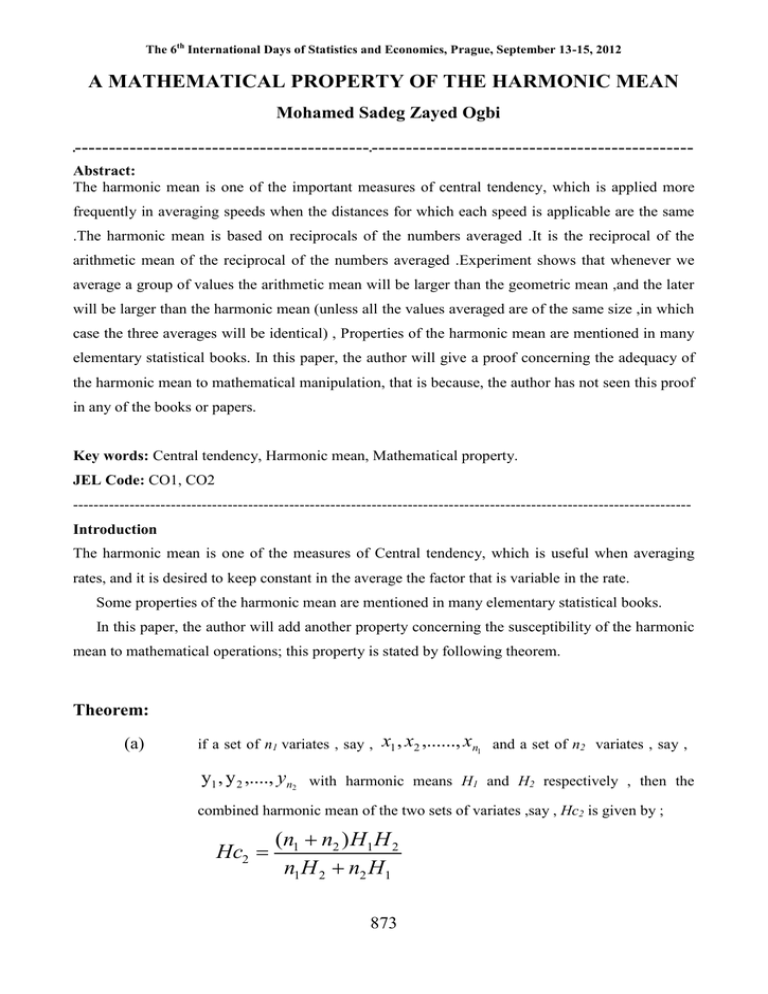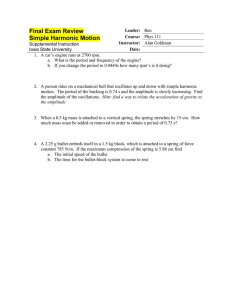A MATHEMATICAL PROPERTY OF THE HARMONIC MEAN ـ-------------------------------------------ـ----------------------------------------------- Mohamed Sadeg Zayed Ogbi
advertisement

The 6th International Days of Statistics and Economics, Prague, September 13-15, 2012 A MATHEMATICAL PROPERTY OF THE HARMONIC MEAN Mohamed Sadeg Zayed Ogbi ـ-------------------------------------------ـ----------------------------------------------Abstract: The harmonic mean is one of the important measures of central tendency, which is applied more frequently in averaging speeds when the distances for which each speed is applicable are the same .The harmonic mean is based on reciprocals of the numbers averaged .It is the reciprocal of the arithmetic mean of the reciprocal of the numbers averaged .Experiment shows that whenever we average a group of values the arithmetic mean will be larger than the geometric mean ,and the later will be larger than the harmonic mean (unless all the values averaged are of the same size ,in which case the three averages will be identical) , Properties of the harmonic mean are mentioned in many elementary statistical books. In this paper, the author will give a proof concerning the adequacy of the harmonic mean to mathematical manipulation, that is because, the author has not seen this proof in any of the books or papers. Key words: Central tendency, Harmonic mean, Mathematical property. JEL Code: CO1, CO2 -----------------------------------------------------------------------------------------------------------------------Introduction The harmonic mean is one of the measures of Central tendency, which is useful when averaging rates, and it is desired to keep constant in the average the factor that is variable in the rate. Some properties of the harmonic mean are mentioned in many elementary statistical books. In this paper, the author will add another property concerning the susceptibility of the harmonic mean to mathematical operations; this property is stated by following theorem. Theorem: (a) if a set of n1 variates , say , y1 , y 2 ,...., yn2 x1 , x2 ,......, xn1 and a set of n2 variates , say , with harmonic means H1 and H2 respectively , then the combined harmonic mean of the two sets of variates ,say , Hc2 is given by ; Hc2 (n1 n2 ) H1 H 2 n1 H 2 n2 H1 873 The 6th International Days of Statistics and Economics, Prague, September 13-15, 2012 (b) If m sets of variates , say , n1,n2,….nm with harmonic means H1,H2,….Hm respectively, then the combined harmonic mean of the m sets of variates Hcm is given by ; H cm m m i 1 m i 1 ( ni )( H i ) n ( H i 1 i j ;m 2 ) j i Where m H i H1H 2 ......H m i 1 Proof: The harmonic mean of the n set of Variates x1,x2,….,xn is defined as: H n n 1 x c 1 c (a) For the proof of part (a); consider the n1 set of variates variates x1 , x2 ,......, xn1 and the n2 set of y1 , y 2 ,...., yn2 . Let H1 and H2 denote the harmonic means of the two sets of variates respectively, then by definition we have; n1 H1 n1 1 i 1 xi H 2 n2 n2 1 i 1 yi And hence we can write 874 .....(1) The 6th International Days of Statistics and Economics, Prague, September 13-15, 2012 n1 i 1 n2 i 1 1 n 1 xi H1 .....( 2) 1 n 2 yi H2 Now Let Hc2 denotes the harmonic mean of the combined two sets of variates n1 and n2, Then by definition , we have: H C2 1 1 1 1 1 1 1 1 ... .... x1 x 2 x3 x n1 y1 y 2 y n2 From (2) ,and after few steps, we can write: HC2 n n H H n1 n2 1 2 1 2 n1 n2 n1 H 2 n2 H 1 H1 H 2 Or HC2 2 2 ni H i i 1 i 1 2 2 n H i 1 i ..........(3) j j i Which completes the proof for part(a). (b) Suppose we have “m” sets of variates n1,n2,…,and nm with harmonic means H1,H2,…..,Hm respectively, Let Hcm be the harmonic mean for the combined n sets of variates .For m=2. the proof is given in (a).Now let us consider the case when m=3, that is we have three sets of variates n1,n2, and n3 which are ( x1 , x2 ,......xn1 ),( y1 , y 2 ,...., yn2 ) and ( z1 , z 2 ,...., z n3 ) with harmonic means H1,H2 and H3 respectively, then the harmonic mean of the combined. three sets of variates is: H C3 n1 n2 n3 1 1 1 1 1 1 ... .... ... x1 x n1 y1 y n 2 z1 z n3 875 The 6th International Days of Statistics and Economics, Prague, September 13-15, 2012 n1 n2 n3 n3 1 n2 1 1 i 1 xi i 1 y i i 1 z i n1 From (2), and after few steps we can write: 3 3 ni H i H C 3 i 1 i 1 3 3 n H i i i 1 j i If we repeat the same procedure for m=4,5,…,etc, then we finally obtain the Harmonic mean of the combined m sets of Variates n1,n2, …, nm with the harmonic means H1,H2,…,Hm respectively, say, Hcm is as follows: H cm n1 n2 ..... nm m3 n1 1 n2 1 1 ....... i 1 xi i 1 yi i 1 z i Again from (2), and after few steps we get: H cm n1 n2 ...... nm H1 H 2 .....H m n1 H 2 H 3 ......H m .......... nm H1........H m1 m m ni H i i 1 i 1 m m n H i i i 1 j i Which completes the proof. 876 The 6th International Days of Statistics and Economics, Prague, September 13-15, 2012 References: 1. Remington D.R and Schork M.A, Statistics with application to Biological Health Sciences, Printce—Hall Inc. Englewood Cliffs.N.J.,1970. 2. Blair M.M., Elementary Statistics, Henry-Holt and Company, Inc. USA 1944. 3. Mode B.C, Elements of statistics, Prentice-Hall Inc. New York,1951. 4. Alder L.H. and Roessler B.E., Introduction to Probability and Statistics, W. H Freeman and Company ,USA,1960. 5. Mohamed S. Z . Ogbi ,Introduction to Descriptive Statistics ,Dar Libya for publication Tripoli ,Libya,2004 , 6. Robert G.D. Steel, and James H . Torrie . ,Megraw-Hill Book Company Inc. USA 1960. Contact Mohamed Sadeg Zayed Ogbi University.of Tripoli Tripoli ,Libya Phone: +218-21-4627910 Fax : +218-21-4628839 Email : m.ogbi@yahoo.com 877





